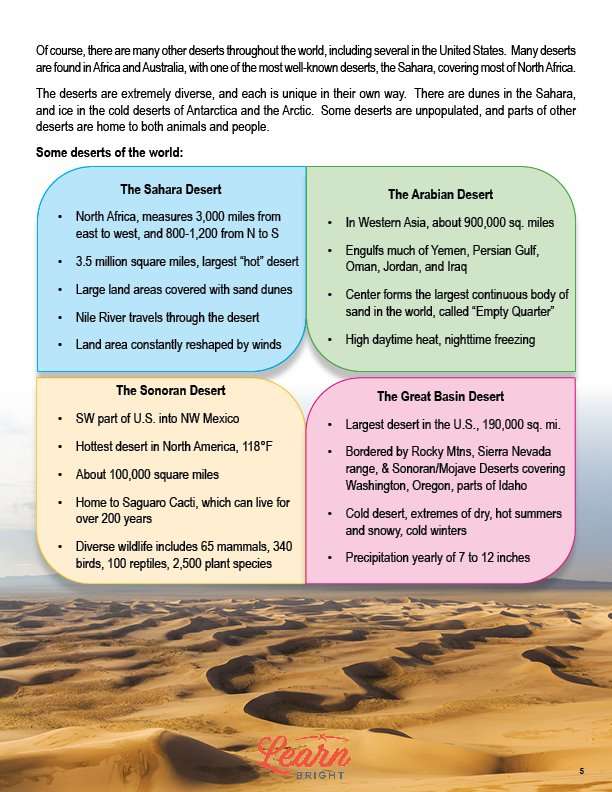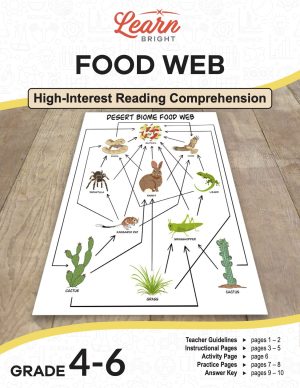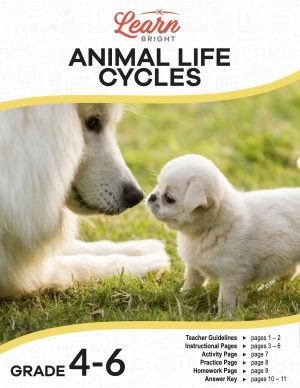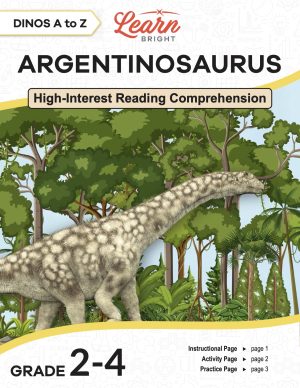Description
What our Deserts of the World lesson plan includes
Lesson Objectives and Overview: Deserts of the World introduces students to several named deserts found throughout the world as an extension of a lower grade lesson which covered the general characteristics of deserts. The information allows students to “travel” to the Sahara, Arabian, Kalahari, Mojave and other deserts of the world. Students will learn their locations and some characteristics of each. At the end of the lesson, students will be able to define desert, locate major deserts throughout the world, and list their characteristics. This lesson is for students in 4th grade, 5th grade, and 6th grade.
Classroom Procedure
Every lesson plan provides you with a classroom procedure page that outlines a step-by-step guide to follow. You do not have to follow the guide exactly. The guide helps you organize the lesson and details when to hand out worksheets. It also lists information in the orange box that you might find useful. You will find the lesson objectives, state standards, and number of class sessions the lesson should take to complete in this area. In addition, it describes the supplies you will need as well as what and how you need to prepare beforehand. The supplies you will need for this lesson are internet access, scratch paper, and the handouts.
Options for Lesson
Included with this lesson is an “Options for Lesson” section that lists a number of suggestions for activities to add to the lesson or substitutions for the ones already in the lesson. One optional addition to the lesson activity is to assign each pair of students a desert to research further and present to the class. You can also have your students research the differences between desert animals and other animals of the world. For another additional activity, you can invite a person who has visited one of the larger deserts to speak with students about their experience. You could have your students create a model of a desert, either by using sand or other materials as ice. Finally, you could have your students create a poster showing the differences between the types of deserts and listing the named deserts for each type.
Teacher Notes
The teacher notes page includes a paragraph with additional guidelines and things to think about as you begin to plan your lesson. This page also includes lines that you can use to add your own notes as you’re preparing for this lesson.
DESERTS OF THE WORLD LESSON PLAN CONTENT PAGES
Deserts
The Deserts of the World lesson plan includes four content pages. Many people imagine sand, no water, and sun when they think of a desert. They might think of cacti, camels, and sand dunes. However, they might not know that we actually have four types of deserts: hot and dry, semiarid, coastal, and cold.
Deserts cover around one-fifth of the Earth and each continent has at least one desert. Deserts get less than 10 inches of rain or snow a year. This lack of water makes it difficult for desert organisms, animals, plants, and people to survive.
Many deserts exist at low latitudes, but some are at higher altitudes. Most of them have specialized vegetation, vertebrates, and invertebrates. These organisms need to be able to survive high heat, low temperatures, and little water. Desert soils can contain many nutrients because all they need is water to produce. They have little to no organic matter.
The animals in most deserts are small. Larger mammals can’t store enough water or handle the high heat. They have few options for shelter from the sun. The dominant animals in a desert could include reptiles and small mammals like kangaroo mice.
We can identify the four types of deserts using several characteristics. Hot and dry deserts stay warm all year and are very hot during the summer. During the winter, they have very little rainfall which happens in short bursts. They have ground-hugging shrubs and short woody trees, and nocturnal carnivorous animals like burrowers and kangaroo rats.
Types of Deserts
Semiarid deserts have moderately long and dry summers and winters with low concentrations of rain. In the evening, temperatures are cool. This helps both plants and animals. Its plants are spiny, silvery, or glossy, and the animals include insects, rabbits, skunks, reptiles, and birds.
Coastal deserts have cool winters and long, warm summers. They average about 3-5 inches of rain a year. Their plants have extensive root systems that are close to the surface, like bushes and sage. Their animals include amphibians, insects, coyotes, badgers, owls, eagles, and reptiles.
Cold deserts have long, cold winters with 6-10 inches of snowfall and high rainfall. They have short summers. The soil is heavy, salty, and silty, and they have widely scattered plants with spiny leaves, like sagebrush. Plants cover about 10% of the ground. Their animals include jackrabbits, mice and rats, and coyotes.
While these are general descriptions of each type, individual deserts vary based on where they’re located. Some deserts might have different plants or animals and temperatures can vary. However, these different types of deserts can be found all over the world. Millions of people visit them every year.
World Deserts
The map in the lesson shows the locations of the major deserts throughout the world. Antarctica and the Arctic, located around the South and North Poles respectively, are the two largest deserts in the world. Antarctica covers 5,500,000 square miles and the Arctic covers 5,400,000 square miles. Both of these are cold deserts, and the desert covers the entirety of the continent of Antarctica. Temperatures range from minus 67° F in the winter to plus 59° F in the summer. They receive less than 8 inches of precipitation annually.
The Arctic desert covers parts of territories owned by Canada, Denmark, Norway, Russia, Sweden, and the United States. Most of the precipitation is snow and temperatures can be as low as -40° F. This desert sees high winds and blowing snow, which makes it seem like there’s continuous snowfall.
The world has many other deserts, including in the United States. Africa and Australia have many deserts. The Sahara, one of the most well-known deserts, covers most of North Africa. Deserts are very diverse and each of them has unique qualities. Some are unpopulated, while others house animals and people.
Some Deserts of the World
The Sahara Desert, located in North Africa, measures 3,000 miles from east to west and 800 – 1,200 miles from north to south. It’s 3.5 million square miles, making it the largest hot desert. It has large land areas covered with sand dunes, and the Nile River runs through it. Winds constantly reshape its land area.
The Arabian Desert, located in Western Asia, covers about 900,000 square miles. It covers much of Yemen, the Persian Gulf, Oman, Jordan, and Iraq. Its center forms the largest continuous body of sand in the world, which we call “Empty Quarter.” It has high daytime heat and freezing at night.
The Sonoran Desert, located in the southwest part of the United States and into Mexico, is the hottest desert in North America at 118° F. It covers about 100,000 square miles and is home to the Saguaro Cacti, which live for more than 200 years. It has diverse wildlife, including 65 mammals, 340 birds, 100 reptiles, and 2,500 plant species.
The Great Basin Desert is the largest desert in the United States, covering 190,000 square miles. The Rocky Mountains, the Sierra Nevada range, and the Sonoran/Mojave Deserts, which cover Washington, Oregon, and parts of Idaho, border it. It’s a cold desert with extreme temperatures during the dry, hot summers and snowy, cold winters. Annually, it gets about 7 – 12 inches of precipitation.
More Deserts of the World
The Great Victoria Desert is the largest in Australia at 220,000 square miles. It has frequent thunderstorms (15-20 annually) and gets 8-10 inches of precipitation. It’s in the least populated area of Australia and doesn’t look like a typical desert because of the amount of vegetation and wildlife. It has no endless sand dunes or barren plains.
The Colorado Plateau Desert, located where Colorado, Utah, New Mexico, and Arizona meet, covers 130,000 square miles. It’s the only place in the United States where four states touch! This desert has high mountain ranges, low river canyons, warm summer, and frigid winters. It also has forested areas. The Grand Canyon is part of this desert.
Deserts are areas that receive less than 10 inches of average annual rainfall. We also characterize them by their high rate of water loss. All of the deserts described in this lesson, and many others, have special features not found anywhere else in the world!
DESERTS OF THE WORLD LESSON PLAN WORKSHEETS
The Deserts of the World lesson plan includes three worksheets: an activity worksheet, a practice worksheet, and a homework assignment. You can refer to the guide on the classroom procedure page to determine when to hand out each worksheet.
10 DAY JOURNEY ACTIVITY WORKSHEET
Students will work with a partner to complete the activity worksheet. Each pair will choose a desert from the lesson and research it, its size, the animals found there, if it has water, and more. Each pair will imagine they’re walking through the desert for 10 days. They will create a journal where they write an entry for each of the 10 days, including information about what they observe.
Students can also work either alone or in groups for this activity.
MATCHING PRACTICE WORKSHEET
For the practice worksheet, students will match characteristics with the correct desert type: hot, semiarid, coastal, or cold. Next, they will read ten statements about deserts and decide whether each is true or false.
DESERTS OF THE WORLD HOMEWORK ASSIGNMENT
The homework assignment asks students to write down the name of the continent where each of the listed deserts is located. They will then match the letter of each continent to its characteristics.
Worksheet Answer Keys
This lesson plan includes answer keys for the practice worksheet and the homework assignment. If you choose to administer the lesson pages to your students via PDF, you will need to save a new file that omits these pages. Otherwise, you can simply print out the applicable pages and keep these as reference for yourself when grading assignments.









